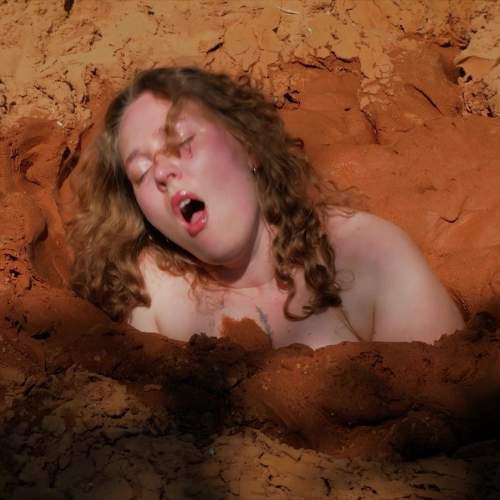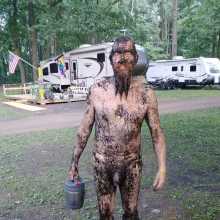|
|
|||
| forums: groups: | |||
|
"Looking for quarry mud in Central Canada"
I've searched across maps on Satellite for countless hours, zooming into rivers and 100s of quarries looking for a good mud spot. The problem is that, where I live it's super flat, everywhere (like Minecraft Superflat world flat), and tree cover is rare unless you go a few hours north, which makes private locations hard to find. I've visited a few river locations I've found on maps but have been dissatisfied by how shallow and sandy it is. There tends to be very little clay here. I'm looking for deeper, stickier mud, so quarries are what I'll attempt next.
I've already checked the mud map, and there is ONE marker in my province in the middle of a field. Seems legit.
Of the many quarries I've searched on maps, maybe 1 in 100 have sediment pools.
The first pic attached is of a sediment pool in a quarry 30 minutes out of town, and is the ONLY quarry I've found that has a sediment pool within an hour's driving distance, and is private enough.
The second pic is a sediment pool is nearby a town next to a highway. It's closer to me, but not private at all. Could maybe be done at night?
The last two pics are of a sediment pool 4 hours from me, and I believe bentonite is mined there. The white flat part is snow in the picture, so unfortunately it's hard to see the larger pond. I visit the city near it sometimes so I'll go there eventually.
What I'm wondering is the specifics of visiting these quarries, so hopefully some more experienced ppl can help me out:
- How do you search for deep mud spots?
- Do the quarries I've found look like they'd have good mud?
- How do you tell apart clay from sand on a map?
- Where do you park your car without looking sus? (Every farmer in a 5 mile radius can see my parked car in a field)
- Have you ever been stuck for a long time?
- Have you ever been caught trespassing?
- What's the absolute best time to go? I'm assuming on a Saturday at night?
- How do you wash up if there's no water nearby? (Shouldn't be a problem in my locations, but I want to plan for anything)
It's ok if not all questions are answered, there's a lot
Unfortunately, there will be snow on the ground here for the next 7 months so I have plenty of time to plan this out lol.
I've already checked the mud map, and there is ONE marker in my province in the middle of a field. Seems legit.
Of the many quarries I've searched on maps, maybe 1 in 100 have sediment pools.
The first pic attached is of a sediment pool in a quarry 30 minutes out of town, and is the ONLY quarry I've found that has a sediment pool within an hour's driving distance, and is private enough.
The second pic is a sediment pool is nearby a town next to a highway. It's closer to me, but not private at all. Could maybe be done at night?
The last two pics are of a sediment pool 4 hours from me, and I believe bentonite is mined there. The white flat part is snow in the picture, so unfortunately it's hard to see the larger pond. I visit the city near it sometimes so I'll go there eventually.
What I'm wondering is the specifics of visiting these quarries, so hopefully some more experienced ppl can help me out:
- How do you search for deep mud spots?
- Do the quarries I've found look like they'd have good mud?
- How do you tell apart clay from sand on a map?
- Where do you park your car without looking sus? (Every farmer in a 5 mile radius can see my parked car in a field)
- Have you ever been stuck for a long time?
- Have you ever been caught trespassing?
- What's the absolute best time to go? I'm assuming on a Saturday at night?
- How do you wash up if there's no water nearby? (Shouldn't be a problem in my locations, but I want to plan for anything)
It's ok if not all questions are answered, there's a lot

Unfortunately, there will be snow on the ground here for the next 7 months so I have plenty of time to plan this out lol.
As you've already discovered, Google satellite view is your friend but it also is useful to know something about the geology of an area as there needs to be clay in the strata being mined for there to be much clay in the settling ponds. With experience you can sometimes tell clay from sandy mud on the satellite view but in most cases the only way to know for sure is to go see for yourself...
With respect to your photo, I can't tell anything meaningful from your 3rd and 4th photo. There definitely looks to be mud in the 1st photo but I can't tell much about how sandy it is. The mud in the 2nd photo looks marginal and likely to be sandy based on the sandy texture seen in the lower part of the photo...
As to where deep mud is in a mud pond, sometimes you can get an idea from how the quarry operates, that is, if they put their settling ponds in abandoned deep excavations, the mud is likely to be deep there. But, other than that, you just have to get in the mud and find out...
As you've already surmised, accessing quarries in flat terrain is problematic. Sometimes the mud pond is below grade and hidden from view if you can work out a way of approaching without being in plain view. Parking these days is a problem everywhere as your vehicle will either be vandalized or attract the attention of the local constabulary if it is not parked in a parking lot. Unless you have a friend to drop you off and pick you up, all that can be done is to find the closest ok place to park and then either walk or ride a bicycle to the quarry...
Trespassing is a constant risk, be sure to know the trespassing statutes in your area and rehearse what you are going to say should things go wrong. Never, ever, admit to there being anything sexual about what you are doing no matter what someone imagined that they thought they saw you doing. Remember, if things go wrong, tell a simple story and if that doesn't work, don't ruin your story by contradicting it or changing it trying to talk your way out, let your lawyer do the talking, the less you've said, the easier it will be for him to craft an explanation...
The best time to visit most quarries is on Sundays but even if the quarry doesn't operate on Sundays, never assume there might not be someone there working on equipment or working overtime. Also, watch your back trail in case your were seen without realizing it, take a break for 10 minutes or so before getting in the mud and just hang out and watch to see if anyone shows up looking for you. Where possible, have an escape route or place to hide in mind...
Keep in mind that there is a limit to what planning can accomplish, you need to expect the unexpected and be able to rapidly make a decision on what to do. Pay attention to your sixth sense, your subconscious sometimes picks up on something, like maybe a minor noise of someone approaching, and perhaps gives you a sudden feeling of unease. Don't dismiss it, pause and verify that all is well...
Be especially careful about any mud that has any amount of sand in it, the more sand the more dangerous it is. Keep in mind that there is sometimes a layer of sand that can trap you under nice clay at the top. Carry a flat board with you when exploring a new mud area to use in dispersing your weight. Socks are fine but never wear shoes in the mud, the edges tend to lock your feet in the mud as you pull upward against the mud. Also, shoes deprive you of the sense of what the mud feels like which is your best way of telling if you have gotten into a sandy area...
Avoid going to a quarry at night, there are many difficult to see dangers there that are impossible to see at night. If night is the only option available, go at dusk and study how the quarry is set up. There are many things to watch for when getting to know a quarry. Sometimes undetonated blasting caps are in the settling ponds. Many quarries have settling ponds that are tiered and have suction pipes draining out of them. Large boreholes that were not used for blasting are sometimes found in unexpected places. Stay well away from cliff faces, they are often ready to crumble with only a little weight...
Never jump into mud from any significant height, if you go too deep you will not be able to resurface. Carefully check any mud area you are in for unseen conditions beneath the mud which could include old equipment, lumber, cables...
If there is no wash up water available, you will need to bring a rag or two and at least a gallon of water and learn how to wet the rags to get most of the mud off before using the remaining water to further reduce the mud you must then let dry and dust off as best you can. Be cautious around wash up water ponds, they are very dangerous and frequently have a vertical drop off right at the shoreline and no foothold available to use to climb out. Never, never wear muddy clothing into or near the edge of a pond, the wet clothing and mud is very heavy and will drag you down...
At least three quarrymen on the mud network are known to have died doing mud at quarries over the years. The one thing that is hardest to have but the most worthwhile to have is a friend that is aware of the specifics of where you go, when you left, and when at the latest you should check back in, and what to do if you are late...
With respect to your photo, I can't tell anything meaningful from your 3rd and 4th photo. There definitely looks to be mud in the 1st photo but I can't tell much about how sandy it is. The mud in the 2nd photo looks marginal and likely to be sandy based on the sandy texture seen in the lower part of the photo...
As to where deep mud is in a mud pond, sometimes you can get an idea from how the quarry operates, that is, if they put their settling ponds in abandoned deep excavations, the mud is likely to be deep there. But, other than that, you just have to get in the mud and find out...
As you've already surmised, accessing quarries in flat terrain is problematic. Sometimes the mud pond is below grade and hidden from view if you can work out a way of approaching without being in plain view. Parking these days is a problem everywhere as your vehicle will either be vandalized or attract the attention of the local constabulary if it is not parked in a parking lot. Unless you have a friend to drop you off and pick you up, all that can be done is to find the closest ok place to park and then either walk or ride a bicycle to the quarry...
Trespassing is a constant risk, be sure to know the trespassing statutes in your area and rehearse what you are going to say should things go wrong. Never, ever, admit to there being anything sexual about what you are doing no matter what someone imagined that they thought they saw you doing. Remember, if things go wrong, tell a simple story and if that doesn't work, don't ruin your story by contradicting it or changing it trying to talk your way out, let your lawyer do the talking, the less you've said, the easier it will be for him to craft an explanation...
The best time to visit most quarries is on Sundays but even if the quarry doesn't operate on Sundays, never assume there might not be someone there working on equipment or working overtime. Also, watch your back trail in case your were seen without realizing it, take a break for 10 minutes or so before getting in the mud and just hang out and watch to see if anyone shows up looking for you. Where possible, have an escape route or place to hide in mind...
Keep in mind that there is a limit to what planning can accomplish, you need to expect the unexpected and be able to rapidly make a decision on what to do. Pay attention to your sixth sense, your subconscious sometimes picks up on something, like maybe a minor noise of someone approaching, and perhaps gives you a sudden feeling of unease. Don't dismiss it, pause and verify that all is well...
Be especially careful about any mud that has any amount of sand in it, the more sand the more dangerous it is. Keep in mind that there is sometimes a layer of sand that can trap you under nice clay at the top. Carry a flat board with you when exploring a new mud area to use in dispersing your weight. Socks are fine but never wear shoes in the mud, the edges tend to lock your feet in the mud as you pull upward against the mud. Also, shoes deprive you of the sense of what the mud feels like which is your best way of telling if you have gotten into a sandy area...
Avoid going to a quarry at night, there are many difficult to see dangers there that are impossible to see at night. If night is the only option available, go at dusk and study how the quarry is set up. There are many things to watch for when getting to know a quarry. Sometimes undetonated blasting caps are in the settling ponds. Many quarries have settling ponds that are tiered and have suction pipes draining out of them. Large boreholes that were not used for blasting are sometimes found in unexpected places. Stay well away from cliff faces, they are often ready to crumble with only a little weight...
Never jump into mud from any significant height, if you go too deep you will not be able to resurface. Carefully check any mud area you are in for unseen conditions beneath the mud which could include old equipment, lumber, cables...
If there is no wash up water available, you will need to bring a rag or two and at least a gallon of water and learn how to wet the rags to get most of the mud off before using the remaining water to further reduce the mud you must then let dry and dust off as best you can. Be cautious around wash up water ponds, they are very dangerous and frequently have a vertical drop off right at the shoreline and no foothold available to use to climb out. Never, never wear muddy clothing into or near the edge of a pond, the wet clothing and mud is very heavy and will drag you down...
At least three quarrymen on the mud network are known to have died doing mud at quarries over the years. The one thing that is hardest to have but the most worthwhile to have is a friend that is aware of the specifics of where you go, when you left, and when at the latest you should check back in, and what to do if you are late...
Tons of good information and safety tips you provided here Quarryman. I wasn't aware of the lost of people over time, this is very sad. Is there a place where the story behind those tragedies could be read?
When I used to scout for mud areas, I'd find that you could almost always just bring a shovel and dig into the earth next to a creek and find great mud. There are a few things to consider though . . .
1. Is the area full of rocks?
2. Is it sandy or clay underneath?
3. Are there trees overhead, causing the earth to be filled with fallen sticks and limbs?
4. Is it private enough, yet with reasonable parking nearby?
Naturally, if you're near a creek or stream, there is no problem with getting cleaned up.
I have learned that mud is everywhere and anywhere, usually just waiting for some water and a shovel.
Once you find a spot where the 'test dig' showed no rocks and hopefully mostly clay, begin by removing the top layer of grass or whatever is growing there. Be sure to get the roots. If necessary, use this to build a small dam between the creek and the mud area.
Because you are next to a creek or stream, the water table ought to be high enough to provide semi-wet soil once you are digging. You should be able to dig a fairly deep trench in a reasonably short time, and if it's too thick, just add water from the nearby stream.
So basically you're not looking for mud already sitting there, which is quite rare, but making your own in a location that will provide it.
I have also found a seasonal element in finding mud. Most shallow ponds with muddy bottoms will dry out in the autumn, so if you can catch them at the right time, you can enjoy the muddy bottom before it bakes in the sun.
One photo is of a meandering creek that had just dried up, but there were trees around, so plenty of sticks in the mud and nowhere to clean off. The other is the bottom of a large pond that had just dried up. It left about three to four feet deep thick, black pond mud, but nowhere nearby to rinse off. I went to the clay area by kayak, and got into and out of the area that way, pushing the kayak through the mud until I got to water again.
1. Is the area full of rocks?
2. Is it sandy or clay underneath?
3. Are there trees overhead, causing the earth to be filled with fallen sticks and limbs?
4. Is it private enough, yet with reasonable parking nearby?
Naturally, if you're near a creek or stream, there is no problem with getting cleaned up.
I have learned that mud is everywhere and anywhere, usually just waiting for some water and a shovel.
Once you find a spot where the 'test dig' showed no rocks and hopefully mostly clay, begin by removing the top layer of grass or whatever is growing there. Be sure to get the roots. If necessary, use this to build a small dam between the creek and the mud area.
Because you are next to a creek or stream, the water table ought to be high enough to provide semi-wet soil once you are digging. You should be able to dig a fairly deep trench in a reasonably short time, and if it's too thick, just add water from the nearby stream.
So basically you're not looking for mud already sitting there, which is quite rare, but making your own in a location that will provide it.
I have also found a seasonal element in finding mud. Most shallow ponds with muddy bottoms will dry out in the autumn, so if you can catch them at the right time, you can enjoy the muddy bottom before it bakes in the sun.
One photo is of a meandering creek that had just dried up, but there were trees around, so plenty of sticks in the mud and nowhere to clean off. The other is the bottom of a large pond that had just dried up. It left about three to four feet deep thick, black pond mud, but nowhere nearby to rinse off. I went to the clay area by kayak, and got into and out of the area that way, pushing the kayak through the mud until I got to water again.
Quarryman already provided tons of great input. Here's a bit more from me.
How do you search for deep mud spots?
Google Satellite view is your friend. Typically quarries have a very evident land scar visible and you can zoom in to see what they look like. Just as you have noted- you look for visible settling ponds. However, ultimately you have to physically check the site to see if the conditions are good. Settling ponds change all the time and could have been recently dredged and filled with water, or dried out and Google's view is not always up to date. You can use a site like Sentinel Playground for a more up to date view, but it doesn't have the same zoom in detail. Exploring in person will also give you an idea of access, privacy, and any possible security.
- Do the quarries I've found look like they'd have good mud?
It's really hard to tell until you go there. If you see a settling pond, there is a good chance. If there is no pond, it's likely they only mine the dry items there and haul it elsewhere for washing.
- How do you tell apart clay from sand on a map?
Again, it's hard to tell purely from the map. In general, sand will have a lighter color of tan (think sand color) while clay will have either a grey or reddish/brown color. That said, there are tan and even yellow clays that are great and might look like sand. You just don't know for sure without testing it out. I will say that cracking is another good indicator. Clay will heavily crack as the surface dries as it shrinks without all the absorbed water.
- Where do you park your car without looking sus? (Every farmer in a 5 mile radius can see my parked car in a field)
I look for absolutely any reason the car could be legitimately parked there. Trail access, river/creek access for fishing, wildlife management areas. I also always carry a backpack/camera equipment for the plausible excuse of being out doing nature photography. I will sometimes even leave a note on my dash saying that's why I'm doing and will be back. Another really good option if you are a biker is to park well away from the quarry and just bike there. Much easier to bike into a quarry unnoticed than to park nearby.
- Have you ever been stuck for a long time?
Never been an issue for me. I've been in really thick mud before that definitely took more effort than others and have sometimes dealt with painful leg cramps as a result.
- Have you ever been caught trespassing?
Not yet. Did have one time where after getting out to my car I did notice a cop car at the quarry entrance. Not sure if it was a standard patrol or otherwise, but they never got out of the car or paid any heed to me. Now, I also exited that quarry via a back way along a conservation easement.
- What's the absolute best time to go? I'm assuming on a Saturday at night?
Saturday/Sunday are best, with Sunday being absolute best as sometimes there are Saturday operations. As quarryman said, best to take some time and observe before hopping right into things.
- How do you wash up if there's no water nearby? (Shouldn't be a problem in my locations, but I want to plan for anything).
These days I generally only get muddy if there is cleanup water as I don't want to haul it in. That said, also as Quarryman mentioned, you can cleanup quite well with very little water and a rag. I bring and hand towel with (takes up less space in the pack than a full towel). By wetting the towel and wiping off, I've been able to get completely clean in something a small as an 8 foot puddle of 1-inch water.
Hope this helps.
How do you search for deep mud spots?
Google Satellite view is your friend. Typically quarries have a very evident land scar visible and you can zoom in to see what they look like. Just as you have noted- you look for visible settling ponds. However, ultimately you have to physically check the site to see if the conditions are good. Settling ponds change all the time and could have been recently dredged and filled with water, or dried out and Google's view is not always up to date. You can use a site like Sentinel Playground for a more up to date view, but it doesn't have the same zoom in detail. Exploring in person will also give you an idea of access, privacy, and any possible security.
- Do the quarries I've found look like they'd have good mud?
It's really hard to tell until you go there. If you see a settling pond, there is a good chance. If there is no pond, it's likely they only mine the dry items there and haul it elsewhere for washing.
- How do you tell apart clay from sand on a map?
Again, it's hard to tell purely from the map. In general, sand will have a lighter color of tan (think sand color) while clay will have either a grey or reddish/brown color. That said, there are tan and even yellow clays that are great and might look like sand. You just don't know for sure without testing it out. I will say that cracking is another good indicator. Clay will heavily crack as the surface dries as it shrinks without all the absorbed water.
- Where do you park your car without looking sus? (Every farmer in a 5 mile radius can see my parked car in a field)
I look for absolutely any reason the car could be legitimately parked there. Trail access, river/creek access for fishing, wildlife management areas. I also always carry a backpack/camera equipment for the plausible excuse of being out doing nature photography. I will sometimes even leave a note on my dash saying that's why I'm doing and will be back. Another really good option if you are a biker is to park well away from the quarry and just bike there. Much easier to bike into a quarry unnoticed than to park nearby.
- Have you ever been stuck for a long time?
Never been an issue for me. I've been in really thick mud before that definitely took more effort than others and have sometimes dealt with painful leg cramps as a result.
- Have you ever been caught trespassing?
Not yet. Did have one time where after getting out to my car I did notice a cop car at the quarry entrance. Not sure if it was a standard patrol or otherwise, but they never got out of the car or paid any heed to me. Now, I also exited that quarry via a back way along a conservation easement.
- What's the absolute best time to go? I'm assuming on a Saturday at night?
Saturday/Sunday are best, with Sunday being absolute best as sometimes there are Saturday operations. As quarryman said, best to take some time and observe before hopping right into things.
- How do you wash up if there's no water nearby? (Shouldn't be a problem in my locations, but I want to plan for anything).
These days I generally only get muddy if there is cleanup water as I don't want to haul it in. That said, also as Quarryman mentioned, you can cleanup quite well with very little water and a rag. I bring and hand towel with (takes up less space in the pack than a full towel). By wetting the towel and wiping off, I've been able to get completely clean in something a small as an 8 foot puddle of 1-inch water.
Hope this helps.
There was a time when I still remembered some of the details concerning the demise of the three mudmen I mentioned but two of them were a long long time ago and I've long ago forgotten any of the details or the details were never shared as there are folks that do not want that type of information presented as it might interfere with the whole mud is a fun thing to do and make money off of folks doing. I do remember that one of them was trapped and died of exposure. The most recent of the deceased was known as NotNormal on the mud network, you can still find info on him if you look. The important thing to note about him is that he was into breath control and messed up. His girlfriend was probably present but elected to craft a missing person story instead of risking some legal consequence by disclosing the truth and the location of his body...
Thanks everyone for the in-depth replies. Lots of safety tips here I've never thought of or even knew about. Thank you for pointing out potential dangers.
I should clarify that 3 and 4 are the exact same location with 4 more zoomed out to show the massive bentonite deposit that is at least 6km long. There's actually like 20 visible pits in that area, sometimes with dirt piles beside or around them. Bentonite deposits here are dug up, dried, and packaged with no washing done, so what's left is a hole that I THINK mud would settle to over time with rain. Seems like a f around and find out situation.
I'll definitely try going to try the river a few more times with a shovel. I know there's sometimes good clay a few feet below, it's just hard to reach sometimes. There's only one spot I have where I can park somewhere without being seen by anyone accept for quadders/bikers that could be out and about. Hopefully the dirt is good there.
When I did construction, I found that the ground here could be all sand from 0m to 5m down, and 500m away there could be plasticy clay from 1m to 5m down. Even though it's flat, the dirt beneath is uneven.
So my list of supplies for my next expedition is:
- A shovel
- A plywood board
- A backpack for my clothes
And if necessary,
- A pail of water
- A few rags
- Soap
Am I missing anything?
Also, I found possibly a better quarry within reasonable distance. On Sentinel Playground (Thanks DriftlessMud), it appears to be completely full or mostly dried up during certain times every year.
I should clarify that 3 and 4 are the exact same location with 4 more zoomed out to show the massive bentonite deposit that is at least 6km long. There's actually like 20 visible pits in that area, sometimes with dirt piles beside or around them. Bentonite deposits here are dug up, dried, and packaged with no washing done, so what's left is a hole that I THINK mud would settle to over time with rain. Seems like a f around and find out situation.
I'll definitely try going to try the river a few more times with a shovel. I know there's sometimes good clay a few feet below, it's just hard to reach sometimes. There's only one spot I have where I can park somewhere without being seen by anyone accept for quadders/bikers that could be out and about. Hopefully the dirt is good there.
When I did construction, I found that the ground here could be all sand from 0m to 5m down, and 500m away there could be plasticy clay from 1m to 5m down. Even though it's flat, the dirt beneath is uneven.
So my list of supplies for my next expedition is:
- A shovel
- A plywood board
- A backpack for my clothes
And if necessary,
- A pail of water
- A few rags
- Soap
Am I missing anything?
Also, I found possibly a better quarry within reasonable distance. On Sentinel Playground (Thanks DriftlessMud), it appears to be completely full or mostly dried up during certain times every year.
The new photos are kind of grainy so it is difficult to be sure of much except that this is the kind of place worth checking out...
You mention soap but note that the only time soap would be of much use is if you have a lot of water as otherwise it will just be an additional something you need to get off of your skin. Water always seems to get me plenty clean...
You mention soap but note that the only time soap would be of much use is if you have a lot of water as otherwise it will just be an additional something you need to get off of your skin. Water always seems to get me plenty clean...
I added soap to the list because based on what I've read, quarry mud has barely any smell, but naturally occuring mud with organic material such as pond or stream mud can leave quite a smell. It's maybe more of a just-in-case item for any non-quarry mud.
What are your thoughts on adding quarry locations to the mud map? It has occurred to me that it may be unwise to point out a location as it may raise security in that area, ruining the fun for everyone.
What are your thoughts on adding quarry locations to the mud map? It has occurred to me that it may be unwise to point out a location as it may raise security in that area, ruining the fun for everyone.
What I'm wondering is the specifics of visiting these quarries, so hopefully some more experienced ppl can help me out:
- How do you search for deep mud spots?
- Do the quarries I've found look like they'd have good mud?
- How do you tell apart clay from sand on a map?
- Where do you park your car without looking sus? (Every farmer in a 5 mile radius can see my parked car in a field)
- Have you ever been stuck for a long time?
- Have you ever been caught trespassing?
- What's the absolute best time to go? I'm assuming on a Saturday at night?
- How do you wash up if there's no water nearby? (Shouldn't be a problem in my locations, but I want to plan for anything)
For me a lot of it is networking with other wammers and going to a mud spot together. Car wise we car pool and park a few blocks away also a license plate is something to consider. How it looks it your not from the area. Washing up wise I bring extra water to use. Most maps don't show mud and clay by time and season usually I check the mud for rocks and branch's before jumping in. Also other creatures like alligators and others that may have claimed ownership over said spot and respectfully remove myself without getting eaten. I've never been entirely stuck and that's in part why I also go with a buddy in case we need each other if something comes up. Like the creature from the black lagoon or mud zombies
- How do you search for deep mud spots?
- Do the quarries I've found look like they'd have good mud?
- How do you tell apart clay from sand on a map?
- Where do you park your car without looking sus? (Every farmer in a 5 mile radius can see my parked car in a field)
- Have you ever been stuck for a long time?
- Have you ever been caught trespassing?
- What's the absolute best time to go? I'm assuming on a Saturday at night?
- How do you wash up if there's no water nearby? (Shouldn't be a problem in my locations, but I want to plan for anything)
For me a lot of it is networking with other wammers and going to a mud spot together. Car wise we car pool and park a few blocks away also a license plate is something to consider. How it looks it your not from the area. Washing up wise I bring extra water to use. Most maps don't show mud and clay by time and season usually I check the mud for rocks and branch's before jumping in. Also other creatures like alligators and others that may have claimed ownership over said spot and respectfully remove myself without getting eaten. I've never been entirely stuck and that's in part why I also go with a buddy in case we need each other if something comes up. Like the creature from the black lagoon or mud zombies
Paint with play and surrender
Disclosing naturally occurring mud locations on a mud map is fine as it is legal to visit these in most cases, however, I never disclose quarry locations on mud maps as in doing so you are making it easy for those with whom you might well not want to share that location with to obtain both the location and knowledge that mud fetishists visit it...
I myself have had problems at several of my quarries because of people who visited that location with me and then later came back without honoring their promise to let me know if they ever visited again and got caught and tried to talk their way out by telling all. There is the additional issue of do you really want someone visiting one of your quarries who you've never met who might be there for some sort of illegal activity beyond playing in the mud?
I once assisted someone in locating a somewhat marginal quarry I knew of in his area only for him to start posting threats on mud forums to anyone who dared visit "his" quarry. Interesting aside to that story, it wasn't long before he got caught and the quarry not only put up all sorts of signs specifically mentioning mudmen but also two super realistic looking at a distance scarecrow "watchmen" on the bluffs above the mud settling ponds. They had old overalls and a hard hat and really gave me a surprise at my next visit!...
Also, note that most mud related forums have someone who is cooperative with law enforcement and shares information on things like mud maps and specific quarries mud fetishists frequent...
I myself have had problems at several of my quarries because of people who visited that location with me and then later came back without honoring their promise to let me know if they ever visited again and got caught and tried to talk their way out by telling all. There is the additional issue of do you really want someone visiting one of your quarries who you've never met who might be there for some sort of illegal activity beyond playing in the mud?
I once assisted someone in locating a somewhat marginal quarry I knew of in his area only for him to start posting threats on mud forums to anyone who dared visit "his" quarry. Interesting aside to that story, it wasn't long before he got caught and the quarry not only put up all sorts of signs specifically mentioning mudmen but also two super realistic looking at a distance scarecrow "watchmen" on the bluffs above the mud settling ponds. They had old overalls and a hard hat and really gave me a surprise at my next visit!...
Also, note that most mud related forums have someone who is cooperative with law enforcement and shares information on things like mud maps and specific quarries mud fetishists frequent...
- How do you search for deep mud spots?
- Do the quarries I've found look like they'd have good mud?
The only way to know for sure is to physically check. Although if it looks muddy it's usually a good start.
Signs of excavation or a visible pond/lake are great signs of potential mud and usually worth investigating on foot.
- How do you tell apart clay from sand on a map?
You can't. Unless its a literal beach and bright yellow- even then you can get clays that colour too.
If you see a distinct colour difference between nearby pits one might be clay and the other sand.
- Where do you park your car without looking sus?
Find a nearby carpark/laybay, otherwise park on the street where its safe/legal. Good points are near footpaths/public trails or points of interest.
- Have you ever been stuck for a long time?
Not yet. Been in shoulder deep too. Closest I've gotten was wearing a wedding dress, with the weight of the mud sticking in it and holding me down. Almost had to slide out of the dress to free myself.
- Have you ever been caught trespassing?
Once, shortly after wild swimming with my partner (no mud), was politely asked to leave. We did and no further issues other than loosing an amazing swimming spot.
- What's the absolute best time to go?
Friday nights can also be good times to go- as nobody really wants to be out working on Friday night. Sunday afternoons are usually quiet too.
- How do you wash up if there's no water nearby?
Remove as much as possible with hands first.
Carry extra water with you, use it sparingly with a cloth to remove the worst of the mud, then a second cloth to clean all the visible parts of your skin (hands/face), get dressed and shower at home.
You can get collapsible buckets/shower trays too to help with clean down.
---When exploring the area:---
Always take snacks, water, drink, and a torch. Nighttime exploring is a bad idea, however with the days getting shorter it's easy to get caught out at sunset.
Disused quarries are much more private than active ones.
Wear dark colours/natural colours so you blend in easier.
Good cover stories could be bird spotting or photography (if you get spotted)- make sure you look the part if you're going for this.
(I have a camera set up when i'm in the mud- gives me the excuse of "I'm on a photoshoot")
Might be worth checking out the other areas that didn't look as promising- sometimes there might be a hidden gem. Also the satellite photos on google can be several years old as well.
The place I go to shows a massive mud bank on satellite, in reality that bank is densely overgrown and very solid. Mud patches are adjacent to the bank and hidden underwater on the satellite.
---When exploring the actual mud: ---
Pack a extra spare pair of socks.
Socks can help protect your feet from sharp sticks/stones in the mud while still letting you feel what's underneath. Shoes are likely to get stuck.
Bring rope (with anchor peg if nothing to tie too) or something inflatable to help you pull back out if you feel yourself getting stuck.
One other point of safety- mud hold in the cold a LOT more than water. Unlike water there's no convection currents to 'stir' the mud and distribute the heat so even in summer you can find a very cold surprise below the warm velvety surface.
- Do the quarries I've found look like they'd have good mud?
The only way to know for sure is to physically check. Although if it looks muddy it's usually a good start.
Signs of excavation or a visible pond/lake are great signs of potential mud and usually worth investigating on foot.
- How do you tell apart clay from sand on a map?
You can't. Unless its a literal beach and bright yellow- even then you can get clays that colour too.
If you see a distinct colour difference between nearby pits one might be clay and the other sand.
- Where do you park your car without looking sus?
Find a nearby carpark/laybay, otherwise park on the street where its safe/legal. Good points are near footpaths/public trails or points of interest.
- Have you ever been stuck for a long time?
Not yet. Been in shoulder deep too. Closest I've gotten was wearing a wedding dress, with the weight of the mud sticking in it and holding me down. Almost had to slide out of the dress to free myself.
- Have you ever been caught trespassing?
Once, shortly after wild swimming with my partner (no mud), was politely asked to leave. We did and no further issues other than loosing an amazing swimming spot.
- What's the absolute best time to go?
Friday nights can also be good times to go- as nobody really wants to be out working on Friday night. Sunday afternoons are usually quiet too.
- How do you wash up if there's no water nearby?
Remove as much as possible with hands first.
Carry extra water with you, use it sparingly with a cloth to remove the worst of the mud, then a second cloth to clean all the visible parts of your skin (hands/face), get dressed and shower at home.
You can get collapsible buckets/shower trays too to help with clean down.
---When exploring the area:---
Always take snacks, water, drink, and a torch. Nighttime exploring is a bad idea, however with the days getting shorter it's easy to get caught out at sunset.
Disused quarries are much more private than active ones.
Wear dark colours/natural colours so you blend in easier.
Good cover stories could be bird spotting or photography (if you get spotted)- make sure you look the part if you're going for this.
(I have a camera set up when i'm in the mud- gives me the excuse of "I'm on a photoshoot")
Might be worth checking out the other areas that didn't look as promising- sometimes there might be a hidden gem. Also the satellite photos on google can be several years old as well.
The place I go to shows a massive mud bank on satellite, in reality that bank is densely overgrown and very solid. Mud patches are adjacent to the bank and hidden underwater on the satellite.
---When exploring the actual mud: ---
Pack a extra spare pair of socks.
Socks can help protect your feet from sharp sticks/stones in the mud while still letting you feel what's underneath. Shoes are likely to get stuck.
Bring rope (with anchor peg if nothing to tie too) or something inflatable to help you pull back out if you feel yourself getting stuck.
One other point of safety- mud hold in the cold a LOT more than water. Unlike water there's no convection currents to 'stir' the mud and distribute the heat so even in summer you can find a very cold surprise below the warm velvety surface.
Sponsors
To avoid content being blocked due to your local laws, please verify your age ?
Sponsors

Design & Code ©1998-2025 Loverbuns, LLC 18 U.S.C. 2257 Record-Keeping Requirements Compliance Statement
Epoch Billing Support Log In





 Love you, too
Love you, too






































